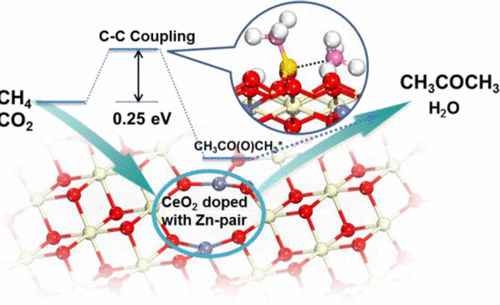当前位置:
X-MOL 学术
›
J. Phys. Chem. C
›
论文详情
Our official English website, www.x-mol.net, welcomes your feedback! (Note: you will need to create a separate account there.)
Active Site Ensembles Enabled C–C Coupling of CO2 and CH4 for Acetone Production
The Journal of Physical Chemistry C ( IF 3.7 ) Pub Date : 2018-04-13 00:00:00 , DOI: 10.1021/acs.jpcc.8b02359 Yuntao Zhao 1 , Hua Wang 1 , Jinyu Han 1 , Xinli Zhu 1 , Qingfeng Ge 1, 2
The Journal of Physical Chemistry C ( IF 3.7 ) Pub Date : 2018-04-13 00:00:00 , DOI: 10.1021/acs.jpcc.8b02359 Yuntao Zhao 1 , Hua Wang 1 , Jinyu Han 1 , Xinli Zhu 1 , Qingfeng Ge 1, 2
Affiliation

|
The production of acetone through ketonization of acetic acid is both energy intensive and environmentally detrimental, as it emits equimolecular CO2. Herein, a novel approach for acetone production from CO2 and CH4 was proposed through consecutive C–C coupling based on an extensive density functional theory computational study. To realize the consecutive C–C coupling, CeO2-based catalyst doped with Zn site ensemble was constructed. Direct coupling of CH3* with the acetate species, formed from C–C coupling of CO2 and stabilized CH3*, could be achieved to produce acetone. The results show that carbon chain growth is possible on the active site ensembles constructed on a CeO2-based catalyst. The coupling of the acetate species with the methyl moiety follows a nucleophilic addition mechanism and has apparent activation energies of 0.25 and 0.14 eV on Ovac (oxygen vacancy) and neutral surfaces, respectively. This process could potentially replace the traditional acetone production technology based on ketonization of acetic acid.
中文翻译:

活性位点集成了使丙酮产生的CO 2和CH 4的CC耦合
通过乙酸酮化生产丙酮既耗能又对环境有害,因为它释放出等分子的CO 2。在此,基于广泛的密度泛函理论计算研究,通过连续的C–C偶联,提出了一种由CO 2和CH 4产生丙酮的新方法。为了实现连续的C-C偶联,构建了掺杂有Zn原子团的CeO 2基催化剂。CH 3 *与乙酸盐物质的直接偶联,是由CO 2和稳定的CH 3的C–C偶联形成的*,可以实现生产丙酮。结果表明,在基于CeO 2的催化剂上构建的活性位点集合体上,碳链的生长是可能的。乙酸酯物质与甲基部分的偶联遵循亲核加成机理,并且在O vac(氧空位)和中性表面上分别具有0.25和0.14 eV的表观活化能。该方法有可能取代基于乙酸酮化的传统丙酮生产技术。
更新日期:2018-04-13
中文翻译:

活性位点集成了使丙酮产生的CO 2和CH 4的CC耦合
通过乙酸酮化生产丙酮既耗能又对环境有害,因为它释放出等分子的CO 2。在此,基于广泛的密度泛函理论计算研究,通过连续的C–C偶联,提出了一种由CO 2和CH 4产生丙酮的新方法。为了实现连续的C-C偶联,构建了掺杂有Zn原子团的CeO 2基催化剂。CH 3 *与乙酸盐物质的直接偶联,是由CO 2和稳定的CH 3的C–C偶联形成的*,可以实现生产丙酮。结果表明,在基于CeO 2的催化剂上构建的活性位点集合体上,碳链的生长是可能的。乙酸酯物质与甲基部分的偶联遵循亲核加成机理,并且在O vac(氧空位)和中性表面上分别具有0.25和0.14 eV的表观活化能。该方法有可能取代基于乙酸酮化的传统丙酮生产技术。



























 京公网安备 11010802027423号
京公网安备 11010802027423号